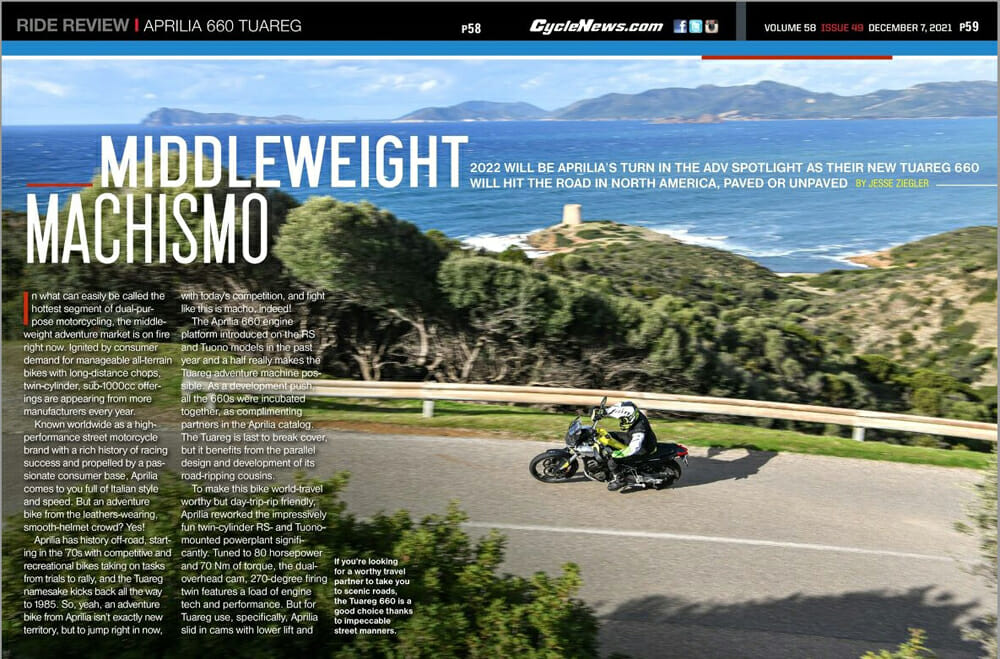Jesse Ziegler | December 9, 2021
2022 will be Aprilia’s turn in the ADV spotlight as its new Tuareg 660 will hit the roads in North America, paved or unpaved.
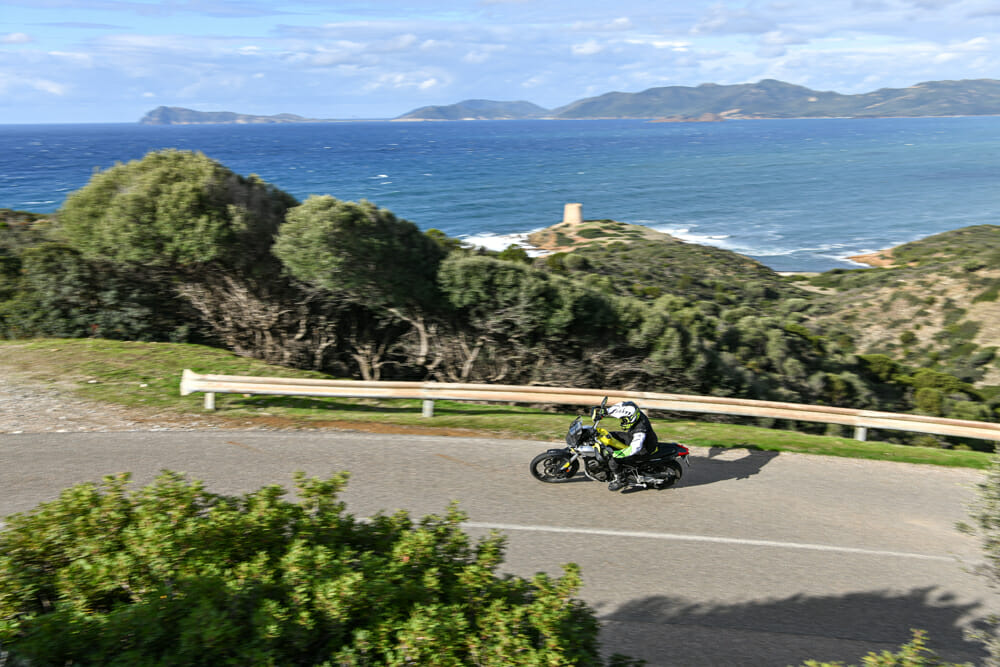 If you’re looking for a worthy travel partner to take you to scenic roads, the Tuareg 660 is a good choice thanks to its impeccable street manners.
If you’re looking for a worthy travel partner to take you to scenic roads, the Tuareg 660 is a good choice thanks to its impeccable street manners.
In what can easily be called the hottest segment of dual-purpose motorcycling, the middleweight adventure market is on fire right now. Ignited by consumer demand for manageable all-terrain bikes with long-distance chops, twin-cylinder, sub-1000cc offerings are appearing from more manufacturers every year.
Known worldwide as a high-performance street motorcycle brand with a rich history of racing success and propelled by a passionate consumer base, Aprilia comes to you full of Italian style and speed. But an adventure bike from the leathers-wearing, smooth-helmet crowd? Yes!
Aprilia has history off-road, starting in the ’70s with competitive and recreational bikes taking on tasks from trials to rally, and the Tuareg namesake kicks back all the way to 1985. So, yeah, an adventure bike from Aprilia isn’t exactly new territory, but to jump right in now, with today’s competition, and fight like this is macho, indeed!
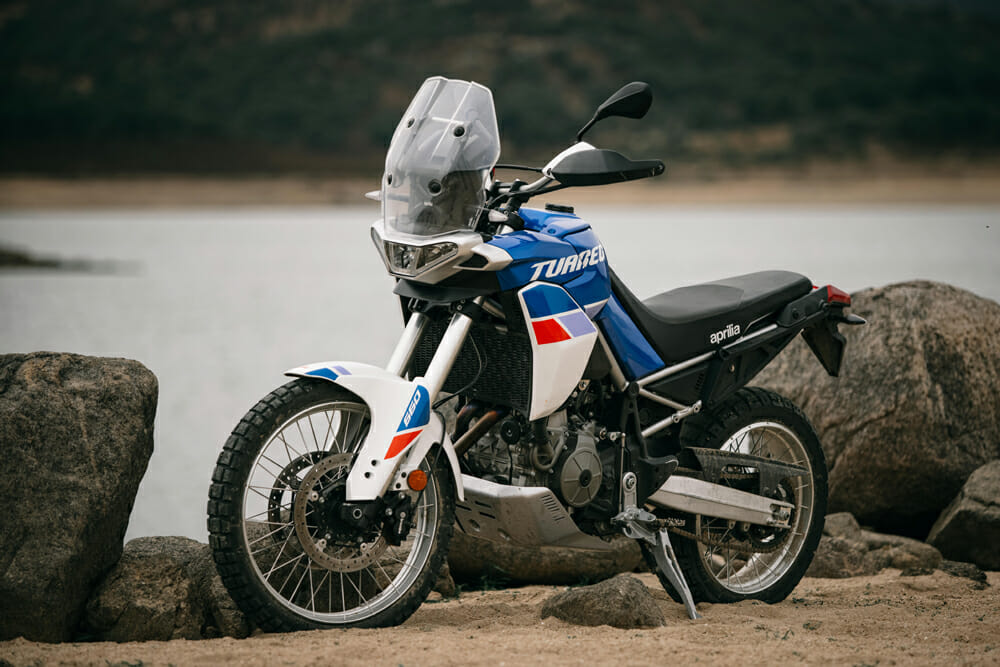 The Aprilia Tuareg certainly looks legit for the ADV world.
The Aprilia Tuareg certainly looks legit for the ADV world.
The Aprilia 660 engine platform introduced on the RS and Tuono models in the past year and a half really makes the Tuareg adventure machine possible. As a development push, all the 660s were incubated together, as complementing partners in the Aprilia catalog. The Tuareg is last to break cover, but it benefits from the parallel design and development of its road-ripping cousins.
To make this bike world-travel worthy but day-trip-rip friendly, Aprilia reworked the impressively fun twin-cylinder RS- and Tuono-mounted powerplant significantly. Tuned to 80 horsepower and 70 Nm of torque, the dual-overhead cam, 270-degree firing twin features a load of engine tech and performance. But for Tuareg use, specifically, Aprilia slid in cams with lower lift and a narrower crossing phase of the cam lobes to boost low-end torque character. A unique air-intake system (somewhat obvious considering its perch above the fuel tank) is also added to the engine to emphasize low-rpm torque with longer ducts. The exhaust system follows the low-to medium-rpm performance bias as does specific ignition mapping.
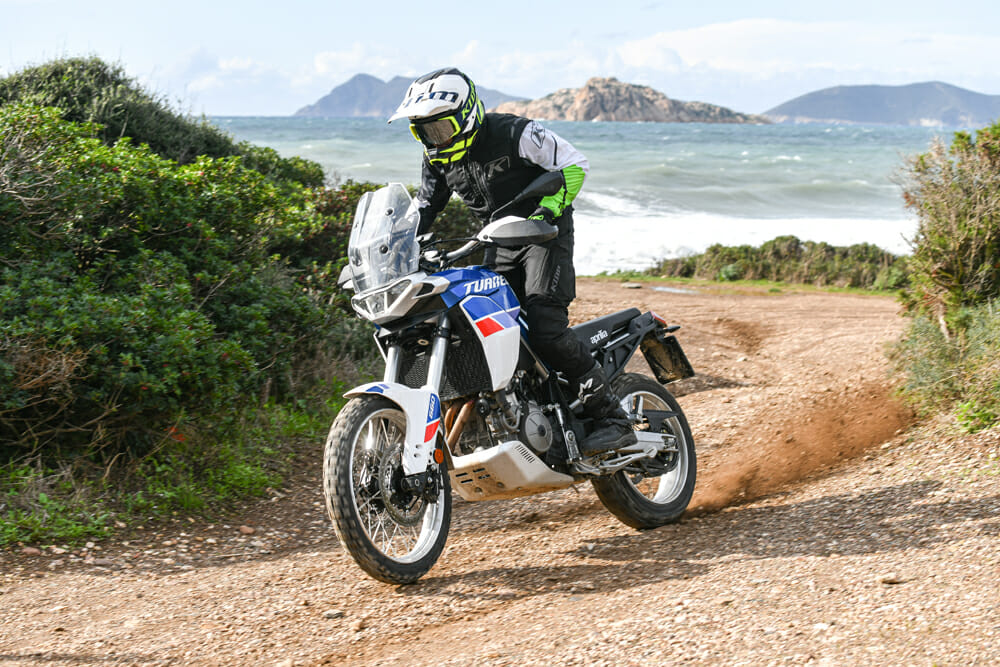 Despite the stock Pirelli Scorpion ST-R street-biased tires, the Tuareg worked well off-road during our test thanks to great weight balance, power delivery, suspension performance and smart electronics that let you turn all rider aids down, or off.
Despite the stock Pirelli Scorpion ST-R street-biased tires, the Tuareg worked well off-road during our test thanks to great weight balance, power delivery, suspension performance and smart electronics that let you turn all rider aids down, or off.
Aprilia says 75% of the 70 Nm of max torque (52.5 Nm) is available at 3000 rpm and 85 percent is on tap at 4500 rpm with max torque pumped out at 6500 rpm—well below the horsepower peak at 9250 rpm. This pairs well with a Tuareg-specific gearbox featuring a shorter first gear and a two-tooth smaller front sprocket to deliver torquier grunt right at the crack of the throttle. On the books, this sounds awesome.
Chassis development also went the full ADV-specific route from Aprilia with the Tuareg. Steel and fully welded frame and subframe units combine to create a touring base worthy of max loads. Yeah, the subframe is permanent and not replaceable, something Aprilia thought was worth the compromise of its 460-plus-pound cargo claims. That’s a lot in your panniers. The 660 engine is stressed and connects to the frame via six anchor points, twice as many as the RS and Tuono. The Tuareg’s engine is also kicked back around nine degrees comparatively, a nod to improved tight-terrain handling on paper.
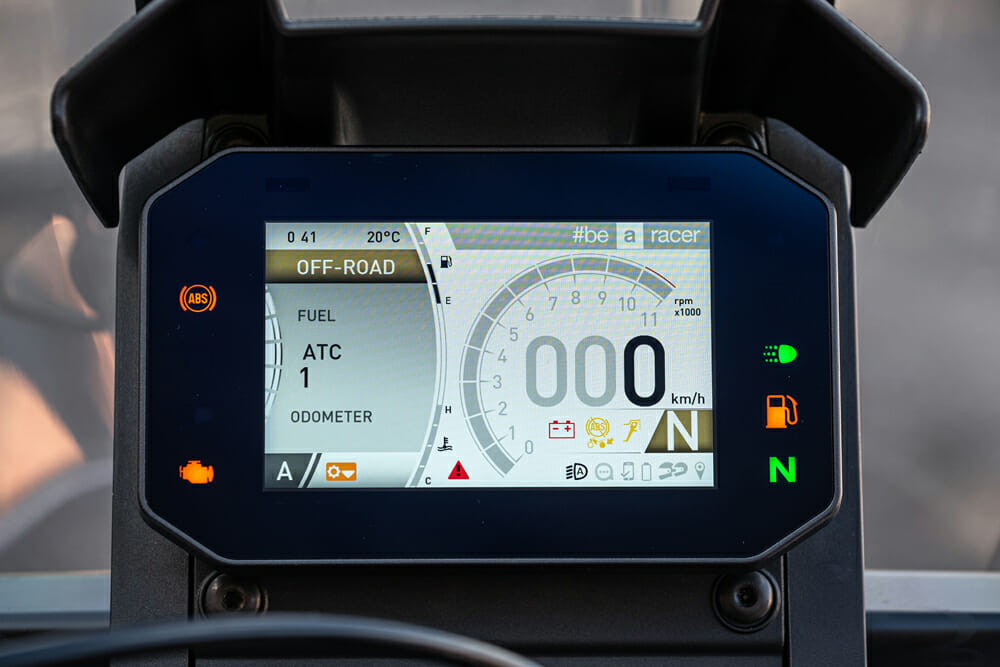 One of the best screens available, the Tuareg unit features bright colors and can adapt to mobile use via an uplink accessory. When equipped, it can display map navigation, and more straight from your phone.
One of the best screens available, the Tuareg unit features bright colors and can adapt to mobile use via an uplink accessory. When equipped, it can display map navigation, and more straight from your phone.
Fuel capacity and chassis/handling go together in the adventure world. And Aprilia has brought a nice combo of capacity and manners here. Holding 4.75 gallons (18 liters) on-board, the Tuareg’s fuel tank slips vertically inside the top frame spars, dropping the weight as low in the chassis as possible and protecting it at the same time. The large “tank” you see on the bike is mostly airbox on the very top, not fuel. Fuel pickup is located right under the seat, at the lowest point of the tank.
Obviously, the Tuareg’s suspension system will have little in common with its sporty in-house cousins. Featuring 9.45 inches (240mm) of travel front and rear, Aprilia equipped the Tuareg nicely for off-road fun with fully adjustable, premium level front and rear Kayaba units. A linkage-connected shock out back connects to an aluminum swingarm and 43mm fork tubes handle the damping up front.
If you’re keeping score so far, we’ve covered an ADV-specific engine, chassis and suspension system on-board the Tuareg 660. What are we missing in today’s touring world? Electronics! Well, Aprilia comes correct with an impressive suite of their Aprilia Performance Ride Control (APRC) and ABS system tuned for all-road use. APRC on the Tuareg 660 includes traction control, cruise control, engine brake and engine-map adjustments. The Tuareg also features the electronic multimap ride-by-wire throttle system. All these systems combine in four pre-riding modes; Urban, Explore, Off-Road and Individual, with different levels of interaction from the system. Urban mode is for easy riding with maximum safety intervention, Explore mode lets the bike thrill more, Off-Road mode delivers usable power with minimum traction control and rear ABS disabled. It’s worth noting you can manually deactivate both traction control and ABS.
Tuareg 660 comes with a 412-pound claimed dry weight, putting it right under 450 pounds full of fuel.
What else does an ADV machine need? Well, it needs to work on the roads and in the dirt, in the real world, and not just on paper.
I rode for a full day on the Tuareg 660 on the island of Sardinia in the Mediterranean Sea. And, as island riding generally offers, the roads offer plenty of turns, there is epic scenery to distract all around, and the always fun dirt connections make adventure bikes the perfect choice, once again.
VIDEO | 2022 Aprilia Tuareg 660 Review
First off, the Aprilia Tuareg 660 is one of the best-handling on-road adventure motorcycles I’ve ever ridden. While the claimed seat height is nearly 34 inches, the bike squats down more than that with a solid foot plant and a slightly bent knee as I settled into the plush seat foam. I immediately was worried the bike was too settled in the rear—a sort of raked-out, chopper setup built to give easy stand-over. But I was wrong. The bike simply stuck to the tarmac. It can be ridden much more aggressively than I can ride on the road, and it will likely stick then, too. The front end provides total confidence—the opposite of what I was predicting in the parking lot. It’s clear that Aprilia built this to perform on the road, and I’d put it up against anything with a 21/18-inch front/rear wheel setup between the stripes.
Certainly, the adventure-tuned 660 power pack helps here. Already a winner on the street in RS and Tuono trim, the Tuareg tune delivers easy-to-use torque in a nimble package. Requiring less skill to carve corners (think: more forgiving wrong-gear scenarios) and more fun pulling out of them (even in the wrong gear). But the engine doesn’t only deliver bottom torque, the lively and open upper range is still there, allowing you to pull through the straight bits just fine. Our test bikes were equipped with Aprilia’s Quick Shift (a $249.95 add-on) so, that helped us leave one corner, and enter the next, too. The Brembo brakes are solid, as they should be.
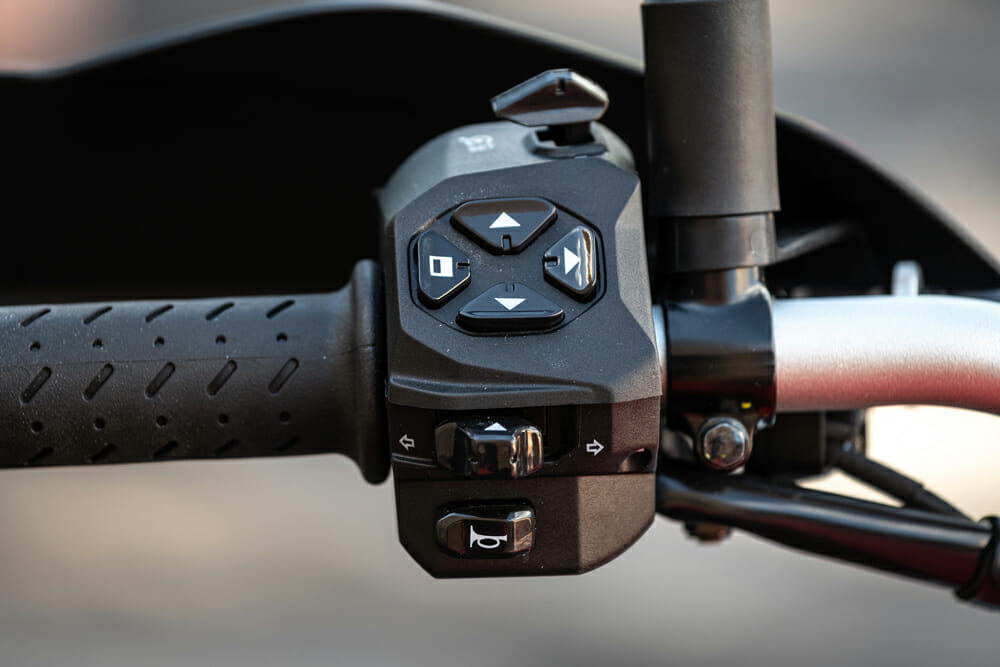 Adjust on-the-fly with big, easy-to-hit buttons. Cruise-control (top switch) is standard.
Adjust on-the-fly with big, easy-to-hit buttons. Cruise-control (top switch) is standard.
The on-road suspension character is active through most of the stroke, but not sloppy. It also has just enough progressive damping structure to keep the bike out of the deep stroke until needed. I scraped footpeg and sidestand edges across the asphalt in quite a few corners, so the limit is there on the edges, but for touring duty, the suspension and chassis goods provide ample hold-up for pushing at a moderately high pace.
Electronics are top-notch in the streets with the pre-programmed Ride Modes providing all you really need to tour. It is fun and effective to manually mix up engine-braking and engine-mapping levels for insight into how the systems work, as well. Kudos to Aprilia for keeping control, or lack thereof, in the rider’s hands, for now. I generally don’t mess with traction control on the pavement. Because, well, I’m a dirt person. I know my size and place on the street and it’s small and careful.
Off-road, while our time was limited, I was surprisingly very happy with the performance of the Aprilia, but I really want some time in the Western United States to test it further and put it head-to-head to the existing standards in the class.
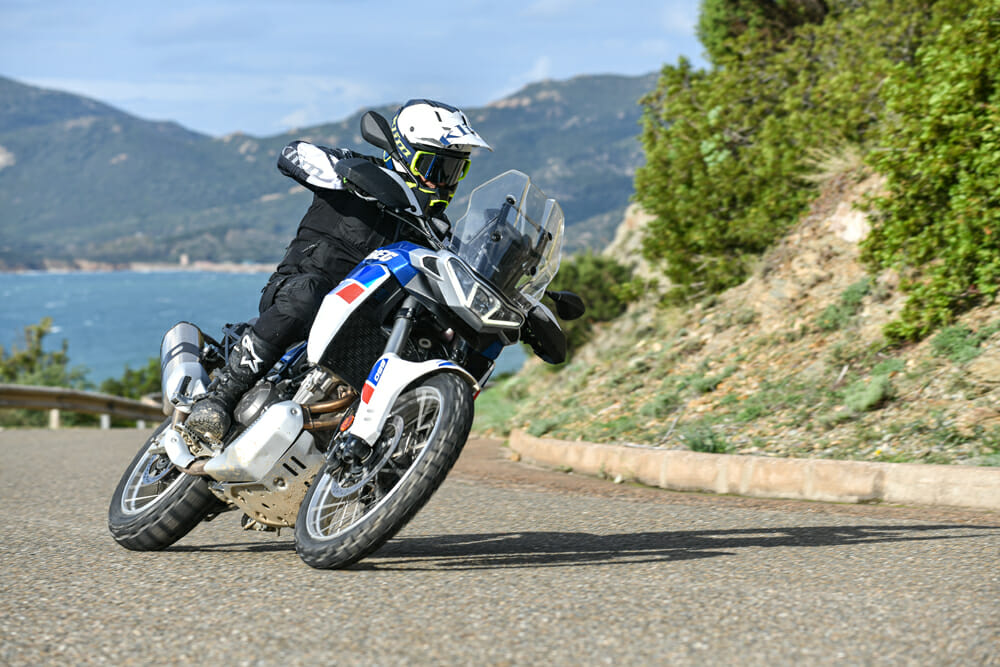 Footpeg clearance on tight turns is easily maxed out, but that’s a compliment to the turning capabilities of the new Tuareg.
Footpeg clearance on tight turns is easily maxed out, but that’s a compliment to the turning capabilities of the new Tuareg.
Again, my parking-lot geometry test-bounces feared for a vague front end feel and sacked-out shock smacking around in a harsh bottom-to-mid stroke. With a seat height about an inch lower than a Tenere 700, I can’t be blamed too much for that. That was not the case. And maybe the seat foam is soft enough to skew my opinion there. But the Tuareg 660 chassis again proved controlled and planted on both wheels, this time in the dirt. The bike’s weight balance is fantastic as the fuel tank does the magic trick of being slim and unobtrusive while also carrying a bunch of gas. The triple threat comes from its ingenious design/placement in the frame, hiding the fuel’s weight centered, low and protected.
I’m not sure if it’s the engine’s power delivery or the chassis, or both, but the Tuareg 660 delivers excellent traction in V-twin style with the smoothness of a parallel. For sure, the power output of the 660 twin compliments everything as it is controlled and grunty with plenty left on top to keep pulling. It’s not as growly (sound or pull) as a Yamaha Tenere 700’s initial torque delivery (it’s closest real on-paper competitor in the market at this time), but it claws its way through the lower rpm range exceptionally well for a relatively small-bore bike. Through the mid and top, it may outperform the Yamaha, but we’ll see.
The suspension works well off-road, too. Initially soft in stroke, the Aprilia impressed with enough hold-up/bottoming resistance to thwart my many attempts to crush the internals with recklessness. I never once heard a terrible bottoming knock. It soaked up the annoying chatter and showed up strongly when I went a little too hard. I think it’s more than competitive as tested to be a great all-around off-road touring machine. It can also party a bit, which is fun.
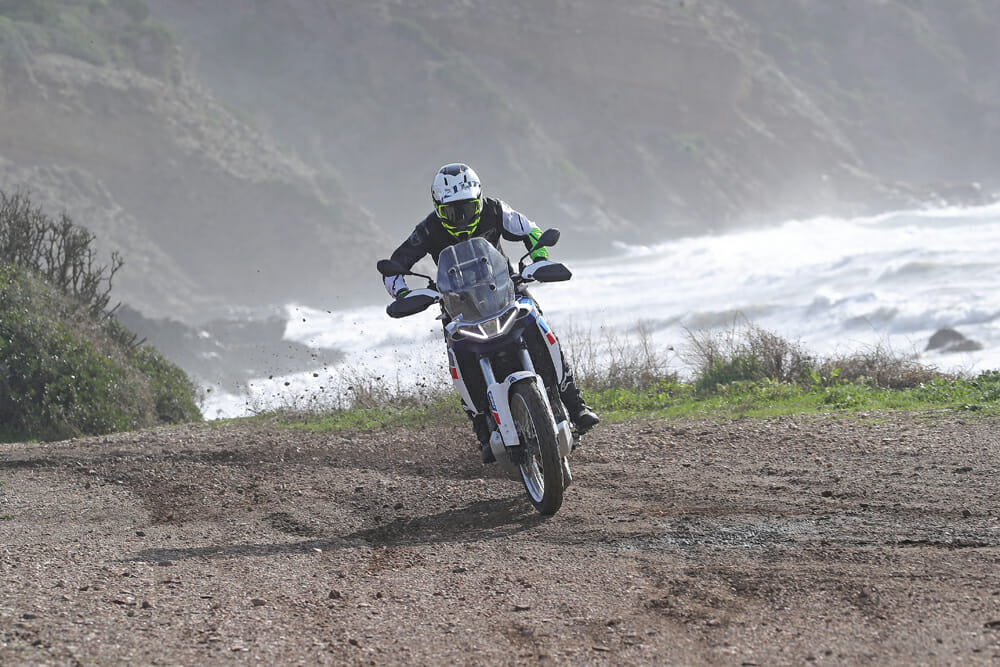 Sardinia is a nice place to ride a motorcycle, but we’re anxious to get a Tuareg 660 in the western United States to see how it handles big country.
Sardinia is a nice place to ride a motorcycle, but we’re anxious to get a Tuareg 660 in the western United States to see how it handles big country.
The off-road electronics benefits are good here. I enjoyed the off-road preset mode that reduces traction control and engine braking effect to almost none, makes the power deliver smoother and disengages the rear ABS. I also just clicked around and messed with making my own setting. You can feel the differences off-road as the traction and ABS effect is more obvious. I’m here for it if I can adjust it and Aprilia did it right.
The big question for this brand-new bike that is quickly running full steam into my consideration zone, is how competitive it can be in the market, and this includes price. The Aprilia Tuareg 660 comes in three colors. The Acid gold and Martian red versions will run $11,999 U.S. and Indaco Tagelmust (it’s the red/white/blue one) is a premium at $12,599. I wouldn’t normally spend $600 on a color, but in real life, the dollars seem worth it. The other colors aren’t doing it for me. Pricing includes all the electronics you’ll ever need or want in an ADV machine except quick shift, and a nice handling chassis and suspension package. There are no cut corners here that I can see, and my only gripes are with a welded-on subframe I can’t replace if I drop this out of my van (which I very well might), and the perimeter-laced, spoked, tubeless wheels. These are common on BMWs and others, yet I’m not really a fan of the exposed rim edge and am not convinced they’re as strong as a center-pulled spoke design.
You can pre-order one of these now, with expected delivery to dealers in February 2022.
And as soon as I get more miles on this bike, you can expect an update. My guess is it’s going to come via a direct comparison to other bikes proving very successful in the U.S. market. My prediction is this bike will hold its own, just fine. CN
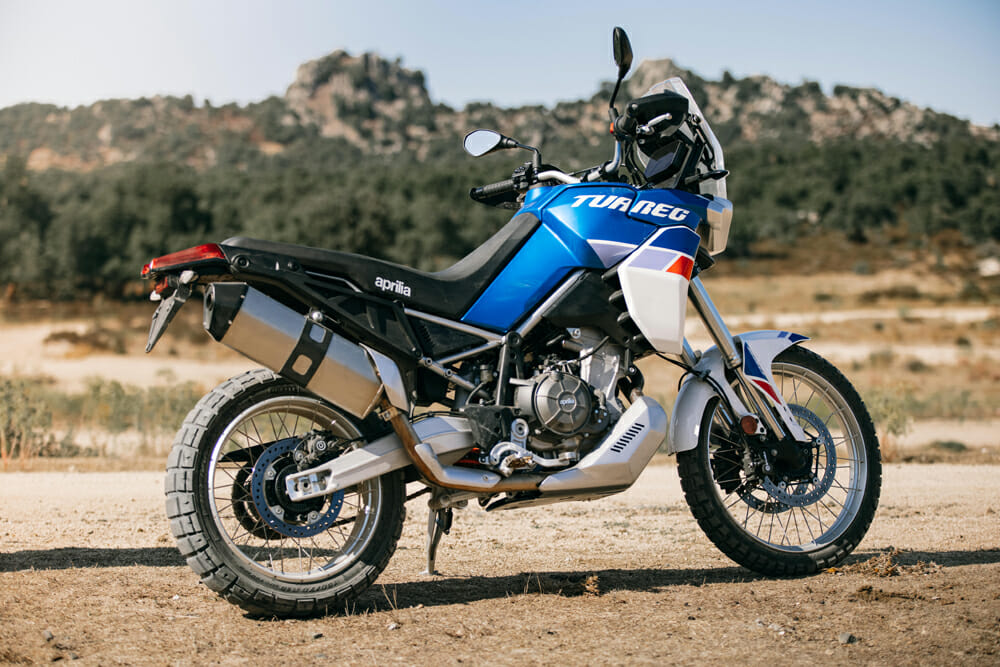 Indaco Tagelmust is this color’s name—a throwback to the Tuareg 600 Wind’s iconic style. Fun to say, and the author’s preferred choice, even though it costs $600 more than Acid Gold and Martian Red, which aren’t as fun to say.
Indaco Tagelmust is this color’s name—a throwback to the Tuareg 600 Wind’s iconic style. Fun to say, and the author’s preferred choice, even though it costs $600 more than Acid Gold and Martian Red, which aren’t as fun to say.
2022 Aprilia Tuareg 660 Specifications
| MSRP: |
$11,999-$12,599 |
| Engine Type: |
Inline, 4-stroke, twin cylinder |
| Valvetrain: |
DOHC, 4-valves per cylinder |
| Bore x Stroke: |
81 x 63.93mm |
| Displacement: |
659cc |
| Compression Ratio: |
13.5:1 |
| Horsepower (claimed): |
80 hp at 9250 rpm |
| Torque (claimed): |
70 Nm at 6500 rpm |
| Fuel System: |
RBW, EFI, w/2 48mm throttle bodies |
| Ignition: |
Electronic |
| Transmission: |
6-speed w/optional Aprilia Quick Shift (AQS) |
| Clutch: |
Multiplate wet with slipper system |
| Final Drive: |
Chain, 15/42T |
| Electronics: |
APRC Suite: ATC (traction control), AEB (engine brake), AEM (engine maps), ACC (cruise control), 4 Riding modes (Urban, Explore, Off-Road, Individual) |
| Chassis: |
Single unit steel frame |
| Front Suspension: |
43mm Kayaba, fully adjustable |
| Rear Suspension: |
Single Kayaba shock, linkage, aluminum swingarm, fully adjustable |
| Front-Wheel Travel: |
240mm |
| Rear-Wheel Travel: |
240mm |
| Front Brake: |
300mm dual disc, Brembo, ABS |
| Rear Brake: |
260mm single disc, Brembo, ABS |
| Wheels: |
Spoked w/aluminum drop center |
| Front Tire: |
90/90-21 in., tubeless |
| Rear Tire: |
150/70R-18 in., tubeless |
| Rake x Trail: |
26.7° x 4.46 in. |
| Wheelbase: |
60.04 in. |
| Seat Height: |
33.85 in. |
| Weight (claimed, dry): |
412 lbs. |
| Fuel Capacity: |
4.75 gal. |
| Colors: |
Indaco Tagelmust, Martian Red, Acid Gold |
